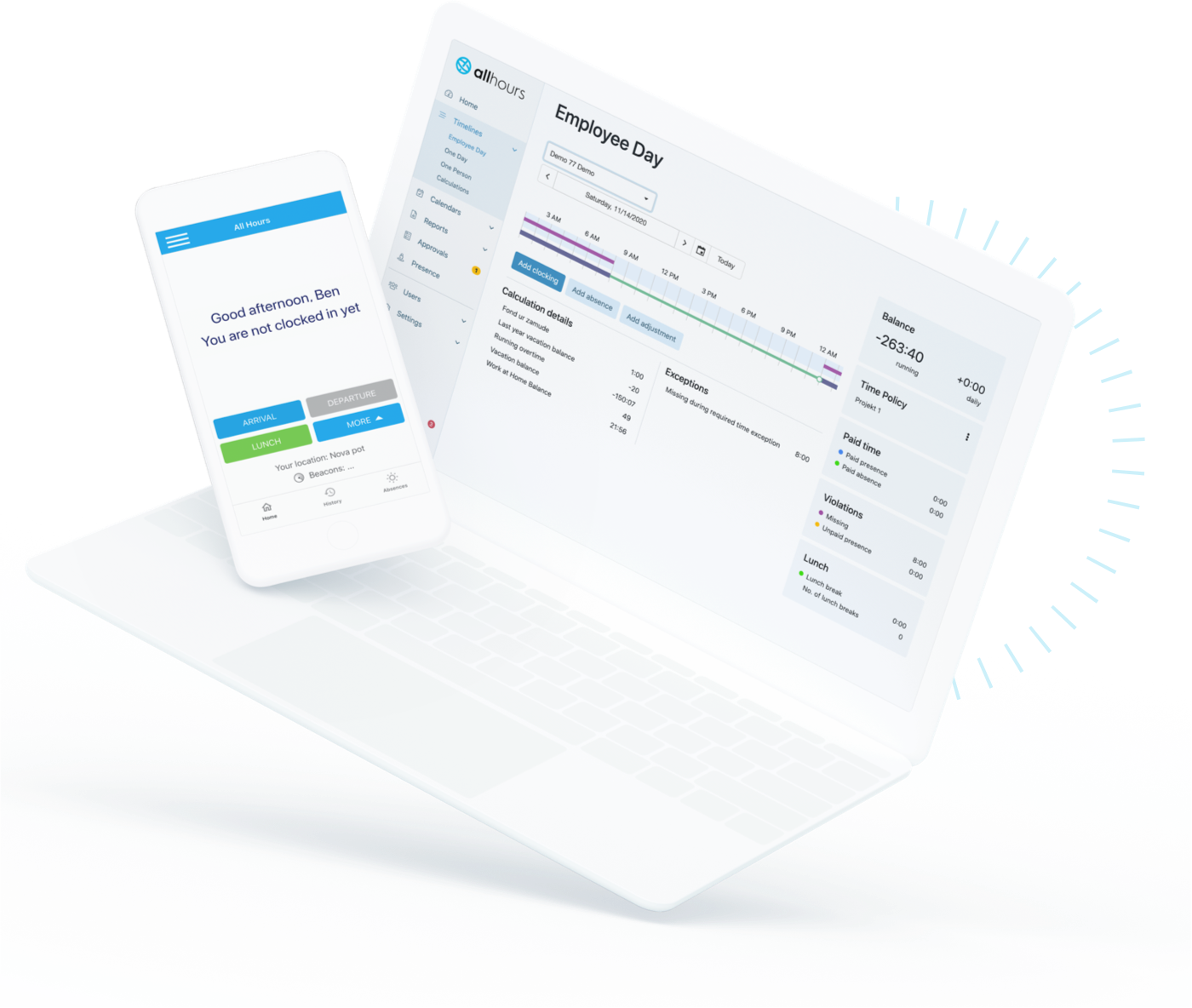Absence Management – why it’s important and what system to use


Absence management means putting strategies, policies, processes, and procedures in place to reduce employee absenteeism due to illness, injury or similar reasons.
In addition, it also means having a system in place to properly manage and record absences for accurate payroll processing.
In this article, we’ll explore why absence management is important, how to approach it, and what kind of system is the most effective to help drive productivity and employee engagement.
At the end of the day, the business processes of the 21st century require streamlined everyday operations. Competition is harsh, customers demand lower prices, and labor costs are optimized down to the cent.
With that in mind, having a good absence management system in place is mandatory.
- Why is having an absence management system in place so important?
- What are the best strategies for absence management?
- 1. A clear absence management policy
- 2. Having flexitime and corporate wellness programs
- 3. Using absence management software
- What can good absence management software do?
- 1. Automate payroll to ensure zero errors regarding absences
- 2. Automate scheduling for easier workforce management
- 3. It’s a fair attendance system for all employees
- 4. It helps to make HR work much more efficient
Why is having an absence management system in place so important?
Several studies, including the CIPD Health and well-being at work survey, have shown that the average employee is absent for approximately 6 working days per year.
The most frequent causes of short-term absences are common illnesses like colds and flus, and the most frequent long-term absences are caused by mental health illnesses.
The all most common underlying causes of absenteeism are:
- Short-term and long-term illnesses
- Stress and burnout
- Injuries
- Child and elder care issues
- Disengagement and low workplace morale
- Bullying
- Time theft
Besides the financial costs, absences cause also other issues like workload rearrangement, shift rescheduling, etc. Usually, other workers must pick up the slack during an absence.
As well as that, The Workforce Management Study conducted by Aptitude Software revealed that the probability of payroll errors in companies with automated time and attendance and absence management solutions is 7 % lower than in companies that process this data manually.
The number may seem low, but this is only the first snowball in a the massive avalanche.
What are the best strategies for absence management?
There are several things that are important to remember regarding absence management, besides employing a good absence tracker:
1. A clear absence management policy
The first thing to do is have clear absence management policies in place. A good absence management policy must inform employees of standards related to absences.
Such a policy must provide a clear process for how absences should be managed and it must make this process clear to employees.
A good absence management policy should provide the following information:
- When and how to inform superiors about the absence
- How an absence is processed from an administrative and scheduling perspective
- When options like flexiwork can be used to reduce absences
- What the pay arrangements are the in case of an absence
- When disciplinary measures are to be taken
- How to reengage in work after the end of an absence, especially a long term one
- How absences are recorded and how data are used
For example, absence management data can be part of HR analytics (that is part of a clocking app), and thus absences can be benchmarked internally among the departments or externally with the industry or competitors.
2. Having flexitime and corporate wellness programs
One important trend that’s connected with absenteeism is workplace or corporate wellness. The main idea of corporate wellness is to help employees make healthier lifestyle choices.
Many companies organize different wellness activities for their employees, such as:
- health educational trainings,
- sport events,
- daily yoga classes,
- smoothies and salad bars,
- healthy snacks at workplace and so on.
It’s a complete “win-win” situation. An employee gets a real opportunity for a healthier lifestyle that leads to better longevity, improved happiness, and better energy levels. There are so many proven benefits of a healthy lifestyle.
And on the other hand, companies that invest in corporate wellness get more productive and energetic employees, and reduce absenteeism.
And as an interesting fact, the Bradford factor analysis shows that recurring short absences have a stronger negative impact on business and costs than long-term absences.
Therefore, if your employee calls in sick, tell them to stay at home and fully recover. This will prove beneficial for employees as well as for your company – they will rest without a guilty conscience, and you will be able to plan according to the available resources.
3. Using absence management software
The best way to manage absences is with the use of a specialized software. Most often, absence management solutions are part of a workforce management platform.
No workforce management platform can disregard absence management, especially in terms of unplanned, frequent and short absences, which typically cause disruptions in workflow and errors in the payroll.
A good absence management software will help you to:
- Make fewer or no errors when it comes to accurate payroll processing due to absences
- Provide HR analytics to have a better insight where absences are outside of the standard
- Reschedule the workload more efficiently
- Raise productivity and drive engagement among employees
- Deal with unauthorized absences more easily
Now let’s do a deep dive into what a good time and attendance / absence management software can do and how can it help you solve your needs and issues.
What can good absence management software do?
As mentioned, absence management software is most often part of a workforce management platform, also known as a time and attendance solution. And you can find many light versions focused only on time and attendance.
Such a software solution provides several functionalities, such as clocking in and out, scheduling the workforce, and of course managing absences in the most efficient way.
Spica offers two such solutions:
- a hybrid/on prem solution (Time&Space) and
- a cloud version (All Hours).
Let’s look at a few of their functionalities:
1. Automate payroll to ensure zero errors regarding absences
Despite living in the era of smart devices and high-tech solutions, the majority of companies still track time and attendance manually and do their scheduling in large paper timesheets.
The outcome? Errors, additional costs, and often also non-compliance with complex labor laws. There are many reasons not to track time and attendance manually.
Imagine an employee receiving a too-low salary due to a payroll error. It definitely causes a lot of frustration; they may even lose motivation and enthusiasm their work. Not to mention that accounting has to make corrections and cannot complete their current on time.
Furthermore, it is often the case that disappointed employees quit their jobs, which causes additional work for the HR department, who have to interview and hire new employees in basically no time. As we all know, this is a demanding and expensive process.
With a time and attendance system such as All Hours, you can easily set reports and export the data you need for payroll processing.
You can also set flexible payroll rules to track regular work hours, overtime, vacation, sick leave, lunch breaks, business trips, shifts, and so on.
Besides payroll processing, using such a system also has compliance benefits.
As of 2020, companies in the EU are required to implement time and attendance management solutions which log audit trails for all registrations and data manipulations.
Employers have to follow the rules on the limitations regarding maximum overtime hours and mandatory minimum rest breaks, and monthly reports should represent the precise outcome of the actual hours spent at work.
2. Automate scheduling for easier workforce management
Advanced time and attendance management solutions, such as Time&Space Dynamic Scheduling, help you easily manage sick leave, vacation time, and all other types of leave in terms of scheduling work.
The platform allows users to individually enter their wishes for the next working period, or propose changes to the existing schedule if an unplanned event occurs. Employees have the overview of their plan, realized hours, sick leave, and remaining vacation days.
With these time and attendance solutions, absence management has never been easier.
Managers can plan according to their real needs, based on business demands. Furthermore, with alarms set to warn you about regulations, you will always be able to stay within the law.
3. It’s a fair attendance system for all employees
When a time and attendance system is implemented, many employees may get the feeling of mistrust and inconvenience.
Maybe their lunch breaks are sometimes a few minutes too long, or maybe they tend to be one minute late in the morning. It’s true, time and attendance management reveals all these little mistakes.
However, if it is brought up for discussion, kindly tell your employees that they will benefit too: no more unpaid overtime, payroll without mistakes, and regular rest breaks should be good enough reasons to have them agree with the new system.
The icing on the cake is the ability to enter their working time wishes and suggest changes to existing schedules, which makes employees active participants in the scheduling process.
At the end of the day, time and attendance software will contribute to a fair attendance system for all employees. If you would like to learn more, read our guide on how to introduce a time clock to employees.
4. It helps to make HR work much more efficient
Absence management helps managers and HR identify absence trends before the real problems occur. Based on the previous seasons or years, they can predict absenteeism trends.
Furthermore, these data also reflect the production levels that require more or fewer workers in one shift. And most importantly, they can enforce rules more consistently and control the cost, risk, and productivity issues associated with absenteeism.
Working time violations, sick leave, vacation, and trainings are the most common reasons for employee absenteeism. As explained in the article “Effects of Absenteeism on Company Productivity, Efficiency, and Profitability” published in the Business and Economic Research journal in 2018, the costs of unplanned absences may represent up to 8.7 % of all labor costs.
This means that productivity decreases by about 20 %.
So, make sure you have strategies, policies, processes, and procedures in place to reduce employee absenteeism and a system in place to properly manage and record absences for accurate payroll processing and other mentioned reasons.







